Drive to Sossusvlei, 2 nights
You will be met at Windhoek Airport by your Explorations guide and begin your journey by driving through the Khomas Hochland mountains and down into the iconic Sossusvlei region, (driving time approx five hours).
Two nights are spent at Kulala Adventurer Camp on the private Kulala Wilderness Reserve, a 37 000-hectare tract of land near the spectacular sights of Sossusvlei, bordering the expansive Namib Naukluft Park. The camp, comprising dome tents under the shade, is perfect for taking in the Reserve’s expansive vistas and stark beauty and enjoys views into the Namib Naukluft National Park.
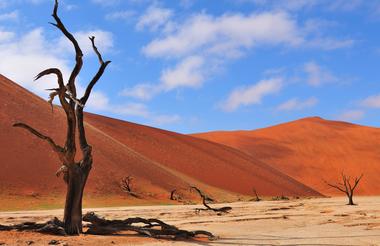
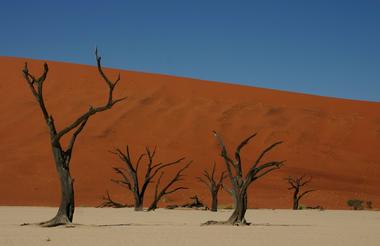
Game drives and walks on the private concession & stargazing
Surrounded by towering, wave-crested dunes of red-orange sand, Sossusvlei is especially breath-taking in the early morning, when the dunes are transformed into explosions of colour by the first rays of the sun. This is paradise for the photographer, as the shadows create a magnificent contrast of colours. Enjoy visits to Sossusvlei, walks in the immense moving sands of the Namib, game drives and walks on their private concession and stargazing. Desert-adapted wildlife such as ostrich, springbok and gemsbok can be seen on the reserve, as well as smaller creatures like bat-eared fox, black-backed jackal and Cape fox.
Optional early morning ballooning, horse riding or quad-biking are also available at extra cost.
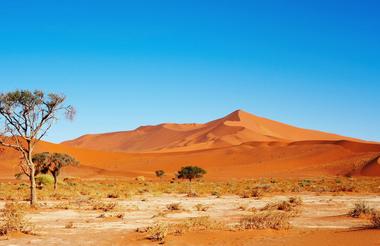
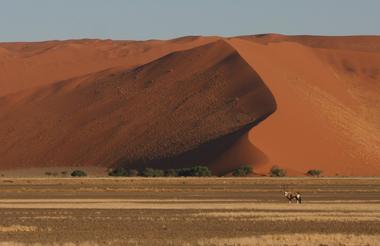
Morning ballooning
Horse riding
Qua-biking
Head to Swakopmund for 2 nights
We depart early, driving through the Kuiseb Canyon and out onto the expansive gravel plains to the quaint town of Swakopmund, a drive of about 5-6 hours (approx 370 km).
This pleasant small resort town on the Atlantic coast has a distinctive continental atmosphere and many picturesque reminders of the German colonial era, deliciously incongruous in the midst of the Namib Desert!
Accommodation is at the Hansa Hotel, an iconic hotel that forms part of Swakopmund’s architectural culture. It is ideally situated in the centre of Swakopmund within easy walking distance of town and the beach. Its excellent cuisine and friendly service are well known.


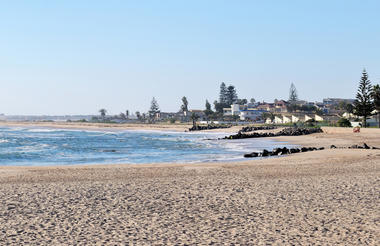
On day 4, we explore the ice-blue Atlantic coast, from the port town of Swakopmund to its incredible marine mammals. A private ‘Dolphin and Seal’ catamaran cruise from Walvis Bay (weather permitting) provides a wonderful opportunity to explore this beautiful bay and coastline. The cruise takes in the Oyster Platforms, where we learn about the oysters cultivated here – including tasting the oysters – before heading to Pelican Point to see the lighthouse, and an area in which three species of dolphins may be encountered, namely the rare endemic Heaviside’s dolphin, dusky and Atlantic bottlenose dolphins. Aside from spotting diverse pelagic (ocean-going) birdlife, pelicans and flamingo, and Cape fur seals, the massive sunfish, leatherback turtles, southern right and humpback whales can all be seen in season.
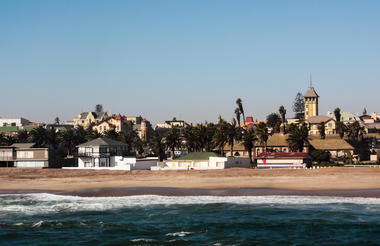
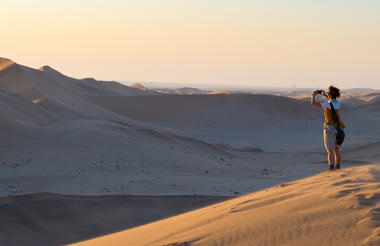
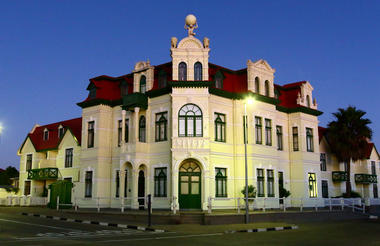
Drive via Cape Cross seal colony to Damaraland, 3 nights
We continue our journey by road (320km, approx 8 hour drive) to Damaraland, west of the Brandberg Mountain, stopping for lunch at Ugab Save the Rhino Trust Camp.
Close to the coast there are lichen fields strewn over the gravel plains, one of the most fragile ecosystems on Earth. You visit Cape Cross: a bewildering cacophony of Cape fur seals.
Once in Damaraland, we are in the heart of the rocky desert, an ancient glacial landscape. Damaraland boasts a varied and breathtaking assortment of desert-adapted species including one of the highest concentrations of desert elephant and black rhino, and a surprisingly high diversity of wildlife including Hartmann’s mountain zebra, kudu, giraffe, gemsbok, and springbok, with occasional cheetah sightings. Our activities range from nature walks, mountain biking, viewing the rock engravings at Twyfelfontein (a World Heritage Site) to day and night nature drives, exploring the mountains, hills and ephemeral river beds and springs.
Looking south from camp toward the imposing Brandberg Mountains, Damaraland offers its guests endless vistas and one of the best wilderness areas in Namibia. Early morning mists generated by the clash between the icy Atlantic Ocean and the warm desert air of the Skeleton Coast, drift inland along the river sand canyon, providing sustenance to the flora and fauna of the region.
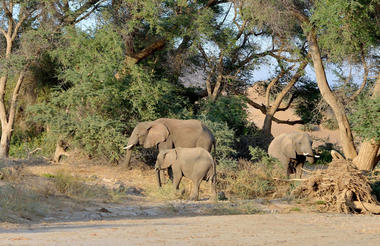
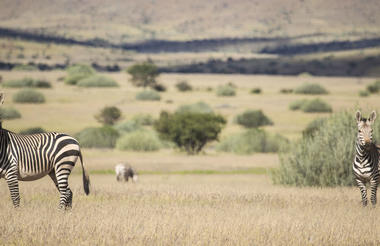
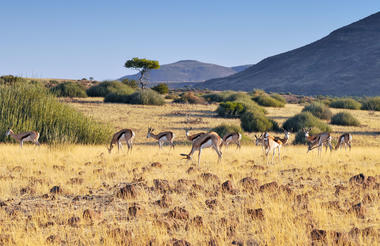
Drive to Etosha National Park, 2 nights
We drive approximately 330km (approx 5 hours driving time) to Ongava Game Reserve on the boundary of Etosha National Park, to experience big game viewing.
Ongava Tented Camp is tucked into a hidden valley at the foot of a dolomite hill in the Ongava Game Reserve, a private 30,000ha game reserve on the south boundary of Etosha National Park. Ongava has three completely different camps to choose from – the authentic Ongava Tented Camp, the larger Ongava Lodge and the ultra-luxurious Little Ongava.
Ongava Tented Camp is an intimate authentic bush camp where spacious traditional East African tents offer a safari ambience on the outside with unexpected luxury on the inside. The bar and dining area is built out of rock and thatch. Meals are taken either around a long communal table or on the deck. There’s a welcome swimming pool overlooking the camp’s popular floodlit waterhole.
Each of Ongava Tented Camp’s eight massive tents has double doors to allow for uninterrupted views of the bush and some have views to the waterhole. Every tent has a comfy chair, writing desk, ceiling fan and dressing area within a spacious bathroom with indoor and outdoor showers. Your private deck offers spectacular views over the wilderness.
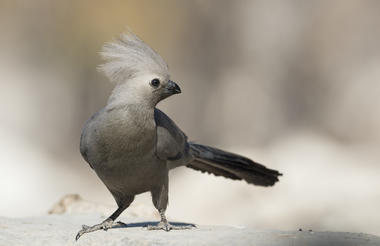
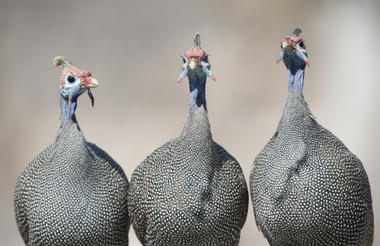
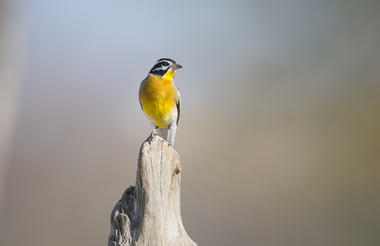
We embark on a full day game drive into Etosha, exploring the southern roads of Etosha Pan, meandering our way from waterhole to spring in search of wildlife.
Etosha remains the highest density wildlife area within Namibia, one of the finest game parks in Southern Africa. The salt pan is speculated to be a remnant of an ancient glacial lake. Springs along the edge of the pan attract and quench the thirst of a dense and varied conglomeration of wildlife, mixing savanna and desert species like impala and springbok.
The pan becomes an immense, shallow lake in rainy periods, attracting great numbers of flamingos and other water birds. During the dry season in Etosha, the open savanna plains beside the pan are home to tens of thousands of animals with large herds of springbok, gemsbok, zebra, wildebeest, elephant and the predators which follow – particularly cheetah and lion. The diminutive Damara dik-dik is one of the rarer but delightful sightings.
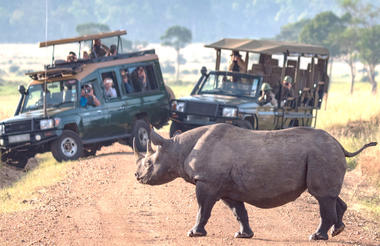
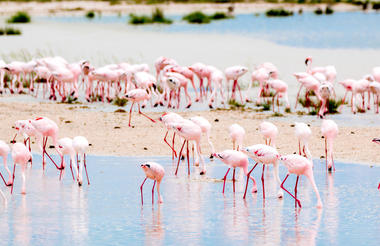
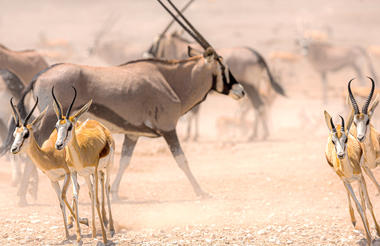
Return to Windhoek
We drive back to Windhoek arriving at approx 13:00 where the adventure ends.





